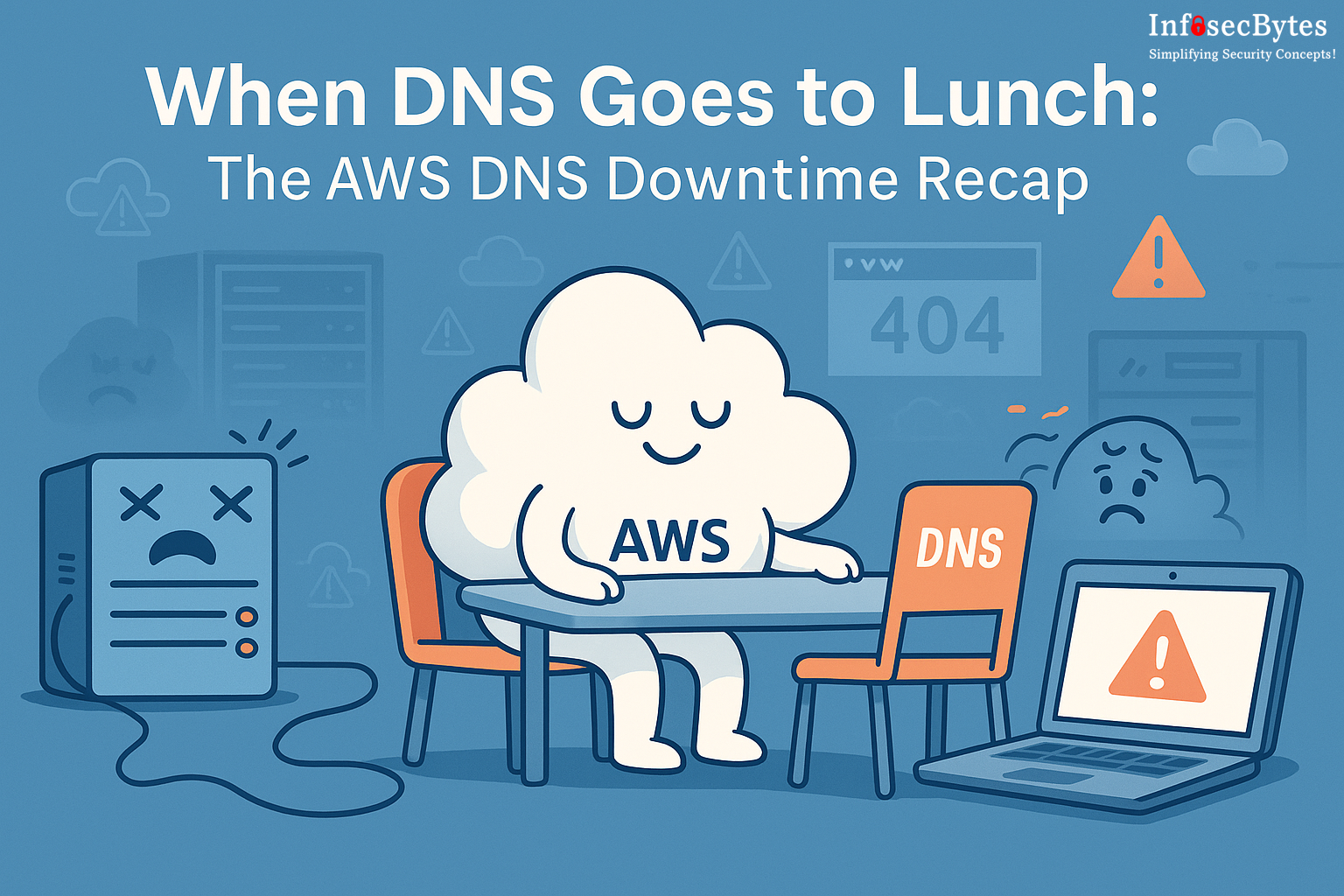Imagine you’re sipping your mooning chai ☕️, checking your laptop for that critical CI/CD pipeline to finish. Suddenly, your slack pings bounce, monitoring alarms roars, your dashboard looks like stock market has fallen, and you wonder: Does the Internet went on holiday without telling me?😳 Well, that’s more or less what happened on October 20th, 2025 when AWS (Amazon Web Services) hit a DNS wrinkle that rippled across many corners of the web. Yes — the cloud, our reliable friend woke up with the misbehaving DNS. Mortals (and DevOps engineers👩💻) everywhere just stared at spinning cursors.
Let’s unpack the tale.🎬
What went wrong and How?
The Sequence of Events
- The incident began around ~3.11AM ET in the US-East-1 region.
- AWS reported increased error rates and latency for multiple services in US-East-1 region, centered around the Amazon DynamoDB API endpoint. 🔌
- The root cause? A DNS resolution issue — in essence, services and clients couldn’t reliably map names to IPs. So many AWS services (and customers of AWS) effectively lost the connectivity. 🔗💥
- The cascade effect: Because DynamoDB is highly used, its malfunction triggered a knock-on impact for many downstream AWS services and customer workloads.
- The fix required manual intervention: an automation bug prevented a self-repair of an empty DNS record in US-East-1 region, which AWS had to disable and manually correct.
Why this one stung badly
- The DNS layer is fundamental. It’s like the phonebook of the internet🌐. When it misbehaves many other services stop working. 🛑
- US-East-1 is a big deal: many AWS services including global endpoints depend on it. So the fault ripples wide.
- Automation gone wrong: the system designed to prevent failure essentially failed to fail-safe.
- The effect spread far beyond AWS’s own websites: apps, banks, IoTs, gaming, streaming — you name it.
What could have been done (or better)?
Since you and I both geek over “how to avoid the next chaos”; here’s the proactive measures and thoughts.
- Redundancy & Multi-region thinking 🧠
Even if you rely heavily on AWS:- Use multiple regions or availability zones for critical services (especially DNS, endpoint resolution, etc.)
- Design so that region specific issues don’t become global show-stoppers.
- For DNS: have fallback name servers, alternative resolvers, maybe even a multi-cloud DNS plan 🤔
- Monitor DNS as a first-class citizen 🔍
Most monitoring focuses on CPU, memory, I/O. But DNS? Often treated as “it just works“- Track resolution latency, errors, timeouts.
- Have synthetic tests: resolve endpoints your services use (including the internal ones), not just the public websites.
- Have alarms on resolution failures — if name-to-IP fails, the rest of the stack might follow.
- Chaos engineering / failure rehearsals 🏋️♂️
Yes, even for the DNS layer.- Simulate DNS failure scenarios: what happens if your primary zone fails, name resolution slows down, or automation mis-fires?
- Playbooks: have runbooks ready for “my DNS resolver is malfunctioning” scenarios.
- Dependency Mapping: know which services you use depends on which DNS records (including internal/external).
- Control and audit automation🕵
Automation is great but when it fails, you’d like safe-guards.- Version control and vetting of DNS automation scripts.
- Ability to quickly disable and roll-back automation changes (e.g. as AWS did after the incident)
- Observe your automation: Did the change happen outside of normal window? Does it match expected pattern?
- Communication & customer impact understanding 👥💬
In large scale outages, what you see is not always what you get.-
Have mechanisms to detect customer-facing failures even when back-end reports look okay (for example DNS resolvers failing but APIs still running).
-
Use independent vantage points (from different ISPs/regions) to catch global impact early.
-
Coordinate SOC/DevOps teams to understand “It’s not my app — resolution failed upstream”.
-
Takeaways & Things to Avoid
🧠 Takeaways
-
The foundational layers matter: DNS might feel boring, but when it breaks you know.
-
Even The Big Guys (AWS) can get DNS wrong — so design as if fault will happen.
-
Automation is a double-edged sword: it reduces toil, but introduces new failure modes. ⚔️
-
Observability & readiness win: you might not prevent every outage, but you can reduce downtime and impact.
-
Multi-layer dependency mapping is essential: your service depends on DNS, on DB, on compute, on network — the weakest link becomes your incident.
🚫 Things to avoid
-
Don’t treat DNS as “just works”. Ignoring it is inviting pain.
-
Avoid single-region, single-resolver architectures — it’s a “why-only-today-did-it-fail” waiting to happen.
-
Don’t roll out DNS automation without safe-guards and rollback plans.
-
Avoid “blind trust” in provider console status alone — complement it with your own health checks/alerts.
-
Don’t assume “it’s only when I deploy” problems happen. Systemic faults (like DNS) can hit when you least expect.
Conclusion
In the grand symphony of cloud infrastructure, DNS is often the piccolo flute: small, easy to overlook, but when it squeals (or stops squealing) you sure hear it. What happened with AWS this time was a painful reminder: even the largest cloud vendor can falter when a foundational layer misbehaves. For us security engineers, platform leads, infrastructure folks — the message is loud and clear: build for failure, monitor the plumbing, and don’t trust that the auto-magic will always rescue you. And when the next DNS hiccup hits (because yes — there will be a next one), you’ll be one step ahead, rather than scrambling with chai ☕️ in hand wondering “why is the CI not running?” 🔄

